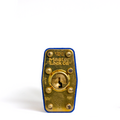Master Lock No 2: Difference between revisions
m (→Gallery) |
m (→Gallery) |
||
| Line 50: | Line 50: | ||
== Gallery == | == Gallery == | ||
<div align="center"><gallery align="center"> | <div align="center"><gallery align="center"> | ||
File:Master Lock No 2 front - FXE48766.png | | File:Master Lock No 2 front - FXE48766.png | Front | ||
File:Master Lock No 2 | File:Master Lock No 2 keyway - FXE48768-2.png | Keyway | ||
File:Master Lock No 2 | File:Master Lock No 2 key - FXE48735.png | Key | ||
</gallery></div> | </gallery></div> | ||
Revision as of 13:43, 28 April 2023
Master Lock No. 2
| Master Lock No. 2 | |
 | |
| Name | Master Lock No. 2 |
|---|---|
| Manufacturer | Master Lock |
| Lock Type | Padlock, Cylinder |
| Lock Design | Pin-tumbler |
| Specifications | |
| # of Components | 4 |
| Component Type | Pin-tumbler |
The No. 2 is a pin-tumbler padlock made by Master Lock. The No. 2 uses a laminated brass padlock body with an internal key-in-knob-style cylinder. The inner cylinder uses four pin stacks and does not use any security pins.
The No. 2 is a common low security padlocks used in the United States.
Principles of operation
The No. 2 cylinder is a pin-tumbler lock with four pin stacks and no security pins. The cylinder typically uses the M1 key profile but may use other profiles, as well. The standard No. 2 can be opened in both directions but the "commercial" series body restricts opening to clockwise rotation. The No. 2 is not a key retaining padlock.
Disassembly instructions
The No. 2 cannot be disassembled non-destructively. To disassemble it the rivets that hold the laminated body together must be removed and each layer removed individually. The inner cylinder itself can be disassembled in the same manner as a traditional pin-tumbler lock:
- Remove the cam or C-clip.
- Insert the key and turn the plug 45-90 degrees.
- Withdraw the plug from the cylinder. (A plug follower is recommended)
OR
- Remove the chamber casings and take out each pin-stack individually
- Remove the cam or C-clip.
- Withdraw the plug from the cylinder.
Notes
- The No. 2 cylinder requires a small diameter plug follower.
- The No. 2 plug is retained by a crimp, rather than a C-clip or cam. Above are the generic pin-tumbler disassembly instructions.
Vulnerabilities
The No. 2 is vulnerable to a wide range of attacks. The reduced pin tumbler count and poor manufacturing tolerances makes it an easy lock to pick. It's commonly given to locksport beginners as a "confidence lock"; a lock that is easy to open and inspires you to continue picking. The No. 2 may be vulnerable to one or more of the following:


